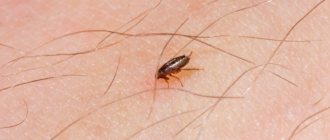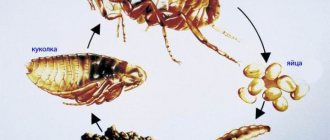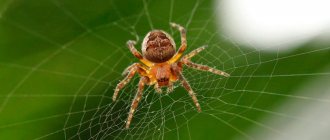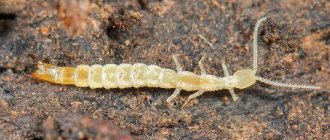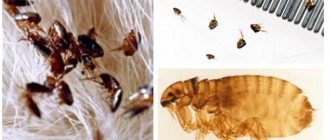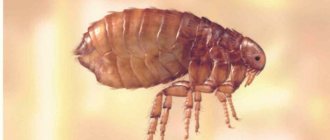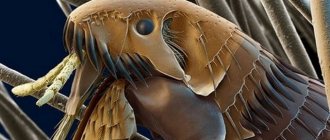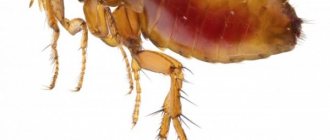Flea infestation in cats is a common and quite unpleasant phenomenon, so it is imperative to combat it. And to prevent re-infection, you need to know how quickly fleas reproduce.
Let's find out what the life expectancy of these insects is and how to properly treat the disease so that you don't have to resort to serious measures.
Life cycle of an insect
After emerging and being released from the cocoon, the female pest is ready to reproduce.
An important condition is the satiety of both partners. To mate, pests do not bother looking for secluded places; the process can occur anywhere. The actions during mating look like this: the female parasite is on top of the male, mounting himself on his back and sucking his seed into herself. The process can take from half an hour to several hours.
After fertilization has occurred, the flea is soon ready to lay eggs. But for the successful process of their maturation, the female parasite should not be hungry. A female flea that has eaten blood can produce a portion of 10 eggs at a time, and in a day, under appropriate conditions, several such portions.
Her actions during laying are curious: the female flea seems to shoot out ripe eggs. This sign is dictated by the logic of flea evolution: scatter the offspring as far as possible from each other so that the hatched larvae avoid the inevitable competition for food, which is inherent in group laying with their parents.
Each female flea, with sufficient satiety, is capable of laying about 500 eggs during the period of its parasitic life. But if she is hungry, laying is impossible.
The life cycle of parasites consists of the following stages:
- egg,
- larva,
- doll,
- imago (adult).
The most comfortable temperature for breeding is 18-25 degrees (then they breed all year round). In cold weather they live but do not reproduce. Before mating, partners eat. The female climbs onto the male's back and takes the genital claw into the spermatic receptacle. Mating lasts several hours, and the seed moves into the female’s body within 15 minutes.
Eggs are laid in small portions. The female ejects small white eggs from her body; they are located quite far from each other. After two weeks, they hatch into translucent larvae without legs, similar to worms. They make their way inside the nest and feed on rotting organic matter, skin epithelium, and blood residues from the excrement of their parents.
https://youtube.com/watch?v=wg5vMlUus0w%3Ffeature%3Doembed
The life cycle of a flea is divided into several stages. An insect with complete metamorphosis.
- Egg. Under favorable conditions, it develops in about 14 days. When the air is very dry and the temperature is above 35 degrees Celsius, the eggs dry out. The same thing happens when you are on a cold surface. The size of one egg is no more than 0.5 mm. They look like a grain of sand. They become noticeable when there is a large accumulation in one place, often under the bedding or rug of animals.
- Larva. The development cycle lasts about 20 days. The rate of conversion also depends on environmental conditions. Under unfavorable conditions it can last up to 1.5 years. With an elevated temperature, she can be born quickly - in 2 days. Flea larvae go through 3 molts. Each time they increase in size. After approximately 18 days it pupates. After 2 days, a new formed flea emerges.
- Imago. Under favorable conditions, an adult lives for 3 months. During this period, 500 individuals of the new generation manage to lay eggs.
Externally, flea larvae differ significantly from adults. An ignorant person, having discovered larvae in his home, cannot understand what kind of parasites they belong to. Photos of parasites are presented below.
A flea is an insect with a very small size of up to 2 millimeters. It can have a different body color - from brown to black. This insect is a parasite and feeds on the blood of warm-blooded animals or humans. Due to its small size and high speed of movement, it does not anesthetize the bite site, and after damaging the skin, the wound begins to itch unbearably. It is this itching that indicates the presence of a flea in the animal’s fur or in the house.
During its life, a flea goes through 4 stages of development:
- eggs,
- larvae,
- dolls,
- imago (this is what an adult is called).
Adults reproduce sexually, after which the female begins to lay up to 10 eggs per day. She tries to find the most favorable environment for them, thanks to which larvae appear from the laid eggs within a few days. They molt three times before pupating. During their life, the larvae feed on the droppings of adults.
During her life, one female can lay up to 2 thousand eggs. If you do not fight insects, then very soon they will infect the entire home. It will be much more difficult to bring them out than the first settlers. Therefore, make every effort to destroy not only the adults, but also the eggs they lay.
How they bite
Flea bites.
When a flea comes into contact with the skin, it makes a puncture on it. Since it does not have a proboscis, in order to get to the blood vessel, the insect spreads the skin and penetrates deep into the skin.
After a bite, saliva enters the wound, which contains substances that prevent blood clotting. At the moment of a bite, an animal or person feels a sharp pain, after which a small wound appears on the skin with redness around it.
Prevention
To never encounter such a problem, you need to follow simple preventive measures:
- If you often visit places where fleas may accumulate (for example, in a dog kennel or a veterinary clinic), then you can use a repellent; it will protect against any parasites. Spray the spray on the body, clothing and accessories.
- After arriving home, carefully examine yourself, so you can notice any parasites that have accidentally appeared on your clothes or body and quickly get rid of them, preventing them from entering your home and further multiplying.
- If you have a pet, take care to prevent flea infestation. As noted above, you can use collars and preparations applied to the coat.
We found out whether fleas live on people. Also, fleas are transmitted under various circumstances. If a person has fleas, they must immediately begin to fight them, as there is a danger of contracting serious diseases. Moreover, the entire apartment, as well as the pet, should be treated, only then will you be able to get rid of pests
This issue needs to be given increased attention, since in the absence of proper treatment, relapses can occur.
https://youtube.com/watch?v=mB4dk6_pug8%3Frel%3D0
How to kill fleas in an apartment
There are many domestic and foreign drugs that allow you to get rid of parasitic insects in your home and apartment. Sprays, powders and solutions saturated with toxic substances will quickly clean the room in which fleas have infested.
When choosing a suitable remedy, you need to remember some of the features that distinguish these insects from other household parasites. Since fleas do not eat anything other than blood, the poisonous substance can enter the body only through the respiratory tract or through contact with the body of the insect. Therefore, any baits and traps for killing fleas are unsuitable.
Unlike adults, larvae are able to feed on semi-decomposed organic matter. They easily find food for themselves in the dust behind the baseboard or in accumulations of garbage. You will have to fight simultaneously with two opponents - mature individuals and larvae. The author of the website VredStop.ru has figured out what helps get rid of fleas in an apartment.
Flea sprays
Pyrethroid insecticides are considered the most effective means used in the fight against ectoparasites. Penetrating into the body through the membranes or respiratory tract, pyrethrin causes paralysis and rapid death of the insect. At the same time, the chemical is safe for pets and humans.
Here are some of the most effective drugs.
- "Dichlorvos TM". The aerosol contains toxic substances such as cypermethrin, permethrin, deltamethrin.
- "Raptor". An effective drug developed by German specialists contains cypermethrin. Odorless, non-toxic for people and animals.
- Raid. One of the world's most famous preparations for crawling and flying insects in the house. The active substance is cypermethrin.
- Combat Super Spray. A broad-spectrum insecticide, the work of which is based on the interaction of two toxic substances - cyphenothrin and imiprotin, which complement each other.
Powder insecticides
In cases where it is not possible to use aerosols in an apartment, you can use a powder insecticide (dust). True, working with such drugs is much more difficult than with sprays, and a positive result will appear only after two weeks.
Powders should be scattered in places where parasites and their larvae may accumulate: in corners and behind baseboards, on carpets and near the trash can. The powder can only poison an insect if it gets on the flea’s body. The most popular drugs at home are Pyrethrum, Delicia, Phenaxin, and Clean House. The cost of powder insecticides is much lower than aerosol ones, but you have to wait much longer for results.
Using Butox
“Butox” is a drug for killing fleas, developed by Dutch scientists and widely used in veterinary medicine. Few people know that this cheap product perfectly helps remove fleas from a house or apartment. One ampoule of Butox is diluted in one liter of water and the insecticide is sprayed with a spray bottle in places where insects accumulate. The treatment can be done several times in a row, combined with weekly cleaning. The effect of using this drug lasts for at least 3 years.
When working with chemicals, the following instructions should be followed.
- Remove people and animals from the house.
- Empty cabinets and drawers, move furniture away from the walls, unscrew baseboards.
- Close windows and doors tightly. The room can only be ventilated 2-3 hours after disinfestation.
- When working with chemicals, you must use a respirator and special protective clothing.
- Treat the room and things with an aerosol.
- After airing, it is necessary to do wet cleaning, wash clothes, and wash toys with soap.
If there are too many insects in the apartment and you are not sure that self-treatment will give the desired result, you can call a special service. Exterminators will quickly and efficiently clean the room from fleas and other insects.
Detection of parasites
The body length of blood-sucking insects does not exceed 2-3 mm, so they are quite difficult to notice. They love to live in floor crevices, behind baseboards, under furniture, in the folds of upholstered furniture, and on carpeting.
The first signs of the presence of parasites are bites that are very itchy and look like red spots. With increased sensitivity and multiple bites, an allergic reaction or dermatitis may develop.
How quickly fleas multiply in an apartment and in cats All about earthen fleas and the fight against them Rat fleas in an apartment and how to get rid of them Elk fleas: description, danger to humans, protection from parasites
You can tell if your home is infested with fleas by actively itching your pets. It is difficult, but you can see small brown or black moving dots in their fur. The pet literally tears the skin, causing wounds that become inflamed and can become inflamed.
NOTE! To quickly get rid of fleas and lice, there are only three effective options:
- Calling a pest control service (expensive),
- Purchase (1390 rubles),
- Chemicals (doubtful effect).
You can also determine the presence of fleas in the apartment by spreading a white sheet on the floor. Dark insects on light fabric will be easy to see.
Lifestyle and behavioral characteristics
Fleas can always be seen, regardless of the time of year, on the owner or in his home. The main carriers are mammals that have a nest, burrow or live in an apartment. Some types of fleas settle in nests left for a long time. Homeless animals do not have their own home, so their fleas live on their bodies all year round and breed there. Parasites suck blood, regardless of gender, from one minute to several hours. When food runs out, insects can live for a long time (months) without food, but then they attack the owner with greed.
Interesting! A flea's jump is about 100 times longer than its body length.
Fight sequence
Having discovered parasites in your home, you need to start fighting them as quickly as possible. Flea control measures should be carried out in the following sequence:
- The path of penetration of bloodsucking insects is determined and blocked. To do this, animals coming from the street must be carefully examined each time. The situation is especially dangerous when parasites come from basements. There they live on rats, which are carriers of many infectious diseases.
- If parasites have already infested pets, then the second stage is to treat the pets. For this purpose, anti-flea agents are used that can kill insects, and drugs for subsequent prevention.
- Fighting fleas directly indoors should be done at the last stage. You can carry out disinfestation yourself using insecticides. You can call professional exterminators. In case of severe infection of the apartment, treatment will have to be carried out several times.
After all the procedures to combat parasites have been carried out, you will need to take preventive measures that will protect the house from re-infestation of fleas.
Anatomical features of fleas
The flea is a special parasite that lives on a warm-blooded “host” and feeds on his blood not only for reproduction, but throughout adult life, and both males and females feed exclusively on blood. Therefore, the anatomy of the insect is fully consistent with these “tasks”.
Of the currently known more than 2000 species, only a few varieties pose a threat to humans, their environment and the economy. These are parasites whose “hosts” are rodents, birds, dogs and cats, other domestic animals, and livestock. As well as domestic fleas, whose eggs and larvae can be laid directly in a human home.
Externally, the pests look very flattened, mostly brown in various shades, insects without wings.
- The body does not exceed 5 mm in length; in the female, during the period of hatching eggs, it can increase to 10 mm.
- The parasite is covered with many tiny spines and bristles.
- It has 3 pairs of limbs covered with bristles, the front - the shortest - clings, the middle - auxiliary - holds, the back - the longest - pushes off to make jumps.
- The organ for piercing the skin and sucking blood is a superbly developed piercing and sucking apparatus.
- There are hidden antennas on the head, which the males put forward during mating and hold the female with them during the mating process.
- At the back there is a special organ that, with the help of hairs, captures even minor vibrations of air, which is called the pygidium.
This anatomy allows the pest to quickly and easily move through wool, hair, down and feathers, between the wings of birds and the folds of skin in animals. In addition, the flea freely clings and moves, changing the angle and direction as desired, on clothing, and jumps into shoes.
The parasite settles in nests, burrows, booths, as well as in people’s homes - in carpets, furniture, bedding and other hard-to-reach places. Soon, if favorable conditions exist, intensive reproduction of fleas begins to occur there.
Description of fleas: lifestyle, body structure
Fleas belong to the order of blood-sucking arthropods. The length of the parasite can reach 5 mm, females after feeding grow up to 1 cm, fertilized ones - up to 1.5 cm. The body of the flea consists of a head and abdomen covered with chitinous cover, the body is flattened on the sides. Thanks to this shape, the insect easily moves among feathers, fur and clothing. Color ranges from yellow to almost black.
Interesting! During the process of evolution, many animals have changed in appearance. Scientists have found that the modern flea looks almost the same as its ancestors.
Fleas do not have wings, and they move by jumping with the help of three pairs of long and strong limbs. Some species have shorter paws, so they are constantly on the host's body. The paw consists of five segments and ends with sharp bristles-claws, forked at the end.
The flea's body is covered with spines and bristles, which helps it move very quickly throughout the victim's body. The head has serrated ridges. Due to this structure, the parasite cannot be combed out, chewed out or removed; it can only be crushed with a fingernail.
At the back of the abdomen is the pygidium, a sensory organ covered with tactile hairs. They react to small changes in air and warn of danger.
The reproductive system of the female consists of the oviduct, ovaries and spermatic receptacle (in the shape of a curved flask), and of the males - the genital claw (copulatory organ).
There are antennas behind the eyes. With them, males hold onto females during mating. The rest of the time they are in the antennal fossae.
The type of oral cavity is piercing-sucking. After biting the skin, the flea enlarges the wound, secretes saliva, which prevents blood clotting, then penetrates deeper and moves to the blood vessel, where it sucks blood. A flea cannot crawl completely under the skin.
Species of cat parasite, adult
An adult cat flea looks like a small grain of a plant. It is difficult to see with the naked eye; in fact, they give themselves away due to the fact that they are constantly moving.
The difference between different types of fleas lies in the structure of the head and the number of bristles on the legs. But, one way or another, any parasite has the following characteristics:
- Oblong body, narrowed at the sides,
- The color of the outer shell is black or dark brown,
- There are no wings.
- The hind legs are longer and are designed for jumping.
After emerging from the larva, two to three weeks later, the female begins to mate with the male. The mating place can be anywhere, from the animal itself to the basement. After mating, the female should feed once or twice to start the process of egg development in her body.
How do fleas reproduce in cats and how to prevent it?
The lifespan of fleas living on pets is influenced by a number of factors. However, the decisive factor here is the presence of a host. Nature gave fleas seven days to find their owner. If during this time the flea is unable to find an animal to parasitize, it soon dies.
Having found a host and settled in the thick fur, the parasite immediately begins to suck blood. After the female flea has found a constant source of food, she begins to prepare for mating.
Many cat owners believe that domestic cats cannot have fleas. Unfortunately, even cats that rarely leave the house are susceptible to parasites. And we should not forget that these bloodsuckers can annoy a person simply by living in his house, regardless of the presence of animals.
You can tell if your domestic cat has parasites by looking at the following changes in your pet’s behavior:
- Cats scratch themselves and try to get rid of fleas with their teeth
- Previously calm cats begin to behave more nervously, twitching their whiskers in their sleep
- The condition of the coat deteriorates
- Animals refuse food
- Flea eggs are visible on fur and skin
However, it should be remembered that these symptoms (except perhaps the last one) are nonspecific and may indicate some other ailment. But if the cause of the animal’s anxiety is precisely these parasites, you need to act very quickly.
Currently, in specialized veterinary pharmacies you can purchase drugs both to get rid of parasites and to prevent their occurrence. There are a great variety of types of drugs on the shelves of pharmacies: from all kinds of sprays to herbs and essential oils.
But first of all, you should remember that fleas reproduce only in an environment favorable to them. This means that timely cleaning will be an effective measure to prevent the appearance of these parasites in an apartment or country house. As for fleas on cats, it is enough to treat the animal only once a year, for example, with drops on the withers.
1klop.com
Insect habitats
Fleas do not live on the animal itself. Insects prefer to settle next to a potential breadwinner: in caves, nests and burrows of animals and birds. This is necessary in order to have free access to food and drink blood at any time.
It is much easier for insects to survive in an apartment or residential building. Their habitats may be:
- bedding and resting places for pets (houses, mattresses, baskets);
- floor cracks, baseboards and carpets;
- bed sheets;
- deposits of clothing;
- furniture, bed mattresses;
- storage areas for vegetables or garbage.
Fleas are very comfortable in carpets and cracks on the floor, as well as in upholstered furniture.
The eggs fall to the floor directly from the animal, so they can end up anywhere, but the most common habitats are those that are closer to the owner - the bed and carpets.
What does a flea egg look like?
It is difficult to distinguish flea eggs with a normal glance. In appearance, they resemble light, slightly transparent rice. Size no more than 1 mm. Can be located anywhere, have a dry surface.
Reference. Fleas lay eggs in the environment and are easily carried on the fur of cats and dogs.
A few days after the egg is laid, a larva emerges from it. If conditions are unsuitable - about 2 weeks.
Flea eggs look the same, this does not depend on the type of animal or the habitat of the adults. Therefore, if small light particles appear, it is impossible to say for sure what type of flea has settled in the room.
The flea larva does not have a bright appearance. It looks like a tiny white worm.
That is, if you examine an insect under a microscope, you will not be able to see the limbs, but the outline of the head will be visible.
You can see the esophagus with food debris. The length of the larva reaches 5 mm. At the metamorphosis stage, the jaw is already developed.
The larva does not change its appearance, it is always the same - on dogs, cats, rats.
Interesting. An adult flea lays almost 800 larvae in 12 months, so you need to get rid of the "mothers" first.
Features of the life of parasites
Fleas are unique creatures with a high survival rate. Insects are not picky about environmental conditions, hardy, and jump well in height and length. They live in dark, secluded places.
The optimal condition for existence is a temperature range from 20 to 30 degrees Celsius, humidity – within 60%. In such conditions, the renewal of offspring occurs every 20 days.
Interesting!
An adult can starve for more than 2 months, but in this state does not lay eggs. Flea pupae can easily tolerate temperatures of -10 degrees Celsius. At a temperature of about 28 degrees Celsius, the larvae emerge from the egg after 2 days.
The behavior, feeding habits, and living conditions of larvae and adults differ significantly. They live in different places and have different taste preferences. This situation provides high survival rates for parasites.
What fleas eat depends on the stage of development. For adult individuals, the source of nutrition is animal blood, in special situations -. The larvae feed on food waste, rot, particles of epidermis, and feces.
Appearance of the larvae
Flea larvae
What flea larvae look like depends on the stage of development. Initially they are born as white, translucent worms. Length does not exceed 1 mm. Their food consists of feces of adults, skin remains, and rot. They begin to eat actively.
Over time, worms accumulate in places where they can find food:
- dog bedding, cat mats;
- trash bins;
- baskets for storing vegetables, flower pots;
- pet toilet, feeders.
A week later, the first molt occurs. Flea larvae increase in size, but do not change appearance. The worms are already more like a caterpillar. The contents of the esophagus are visible through the transparent body. The color becomes dirty gray. During the entire developmental stage, the flea molts three times. Increases to 4 mm.
At the last stage of flea development, pupation occurs. The larva envelops itself in a cocoon and stops moving. Already after 2 days it emerges from there as an adult.
On a note!
Flea larvae do not live on cats' bodies. You should look for them near the sleeping place, near the toilet. Check all the places where your pet likes to relax and spends a lot of time. Dogs also develop fleas. Animals are not even the host for these parasites. Development occurs outside the body.
Types of fleas
The order of insects under consideration includes more than 2,000 species, united by a common structural plan and a similar way of life: all of them in adulthood feed on the blood of animals and people. But each species has its own characteristics, most often they relate to body structure and commitment to a specific owner. The most common species on the planet are as follows:
Feline
It most often parasitizes cats, but is also found in humans, dogs, rats, mice, and other mammals. The body length is about 5 mm, but a fertilized female, ready to lay eggs, can reach 1.5 cm in length. Individuals of both sexes have a flat forehead, 1-2 large setae on the thoracic segment, thick setae on the hind legs and an elongated proboscis, with which they pierce the skin and draw in the blood of the victim.
The eggs laid are white and do not exceed 0.5 mm in size. The worm-like larva consists of 3 thoracic segments and 10 abdominal ones. The adult can live up to the age of 2 years.
Doggystyle
Occurs in animals (usually dogs) and people. In terms of body structure and size, the parasite is similar to a cat flea, but there are also main differences by which the species can be identified: a more rounded forehead, an expanded genital claw in males, 3 large bristles on the thoracic segment, and an even longer proboscis.
The appearance of eggs, larvae and pupae is similar to those of cat fleas. Life expectancy under favorable conditions reaches 1.5 years.
Chicken
A blood-sucking insect of a brown-black hue, not exceeding 1.5 mm in size. Parasitizes exclusively on birds, domestic and wild. These insects form large clusters in the eye area, beak, and comb of hens and roosters. If there are a large number of parasites, the animal may die from exsanguination.
Human
A pest that often feeds on human blood, but is also found in animals, including wild ones. The body color of the pest ranges from rich beige to dark brown. The main differences between the species and others is the absence of thick bristles and denticles on the chest shell. The pest also has very short proboscis, which is why it has to immerse its head in human tissue when feeding. These parasites often hide in a person’s clothing, and lay egg clutches in secluded corners of rooms.
All the distinctive features of the pests listed above cannot be detected with the naked eye due to the small size of the insects. And in terms of their food source, these parasites are not very picky; any of the insects presented can with equal probability feed on the blood of people, wild or domestic animals. For reliable identification, you need to provide a scientist who understands entomology with a large photo of fleas, or even better, a live insect.
Origin of the species and description
Photo: Flea
Fleas form a small group of insects that are probably descended from the ancestor Mecoptera (scorpions), with which they share certain characteristics. Both groups have a spinous stomach, sex differences in the number of ganglia in the ventral nerve canal, six rectal glands, and a simple ovary type.
Males have a similar type of sperm, unique to the arthropod phylum, in which a motile flagellum or tail, lacking an outer ring of nine tubules, is located around mitochondria (cellular organelles). Fossil fleas discovered in Australia are said to be 200 million years old. Two other known fossil fleas come from Baltic amber (Oligocene) and are very similar to "modern" fleas.
Video: Flea
Because fleas are capable of jumping horizontal or vertical distances up to 200 times their body length and achieving accelerations of 200 g, they have been described as insects that fly with their feet. Some species that live in nests high above the ground or in other unusual habitats crawl rather than jump.
Fun Fact: Occasional uses of fleas' unusual strength occur in "flea circuses" in which they pull miniature carts and perform other feats.
Types of parasites
There are more than 2 thousand species of fleas, but about 30 of them are blood-sucking. To the naked eye, they look almost the same. But if you look closely, you can see the differences. For example, the head of dog parasites is larger than the head of cat parasites.
Main varieties:
- felines,
- chicken,
- rat,
- canine,
- human,
- earthen,
- sandy.
An unpleasant fact: they can migrate and drink the blood of other warm-blooded animals, birds, rodents, cold-blooded animals and humans. All types of bloodsuckers live in the temperate climate zone, except sandy ones. The habitat of the latter is tropical countries, coastal sea sand. The peculiarity of this type of flea is that the females penetrate under the human skin, dig into the vessels of the circulatory system, and lay eggs there under the skin. After the larvae emerge, the females die and rot.
Flea control
In case of mass infection, it is worth considering that most folk remedies act as prevention. To destroy parasites, it is better to choose an industrial insecticide or contact specialized organizations. If you decide to do it yourself, do the following:
- Identify the source of the infection. Having established where fleas got into your home, eliminate the possibility of their reappearance: seal cracks and cracks in the floor, walls, and ceiling.
- Don't forget that fleas are carried by animals on their fur. Rid them of parasites and take measures to ensure that the infection does not recur. Use special collars, sprays and long-term exposure products for this. The flea collar is impregnated with a product that repels parasites from your pet
- Using the chosen product, carefully and scrupulously treat the property.
Treat premises against fleas using protective equipment: gloves and a respirator. All residents of the apartment, including pets, must block access to the premises during treatment.
To prevent fleas from reappearing, consider several factors:
- Killing adult insects will not rid your home of fleas. When choosing a product, give preference to what kills them at all stages of development.
- Process the room without missing a single centimeter. Parasite eggs and adult insects can hide anywhere, even under the ceiling.
- The residual effect of the drug used lasts up to 1 month. During this period, avoid wet cleaning, otherwise the parasites will survive.
- Carry out the treatment in the morning. Since the room must be closed at this time, it will take time to ventilate it afterwards. If possible, do not limit yourself to just gloves and a respirator when working with chemicals: use full-body protection
- Prepare the room in advance - open access to baseboards and other hard-to-reach places, remove fabrics that can be washed (furniture covers, curtains, capes), remove carpets from the walls, bolsters and mattresses from beds and sofas.
- If the room is heavily infested, in addition to the main drug, use long-acting powders, scattering them after treatment in places where fleas are most likely to appear.
Take flea control measures at the first sign of fleas. Parasites are fertile, and if you leave everything to chance, then after a while your home will be overflowing with bloodsuckers.
Photo gallery: types of flea control products
The most popular products in the fight against fleas are emulsions.
Modern flea treatments are available in aerosol form for convenience.
Safe for people and animals, but effective against fleas, pyrethrum powder is poured into all hard-to-reach places in the house.
To rid pets of fleas, medications in the form of shampoo, drops, tablets or anti-flea collars are used.
When dealing with fleas, it is important to remember that local destruction of parasites is wasted time. Treating a pet or the only ottoman favored by fleas will not give any results.
Use the information received, do not forget about preventive measures, and fleas will not bother you.
Animal handling rules
To achieve a positive result when using flea products, you must follow the following rules:
- The dog should not be bathed 2 days before and after treatment. This is due to the fact that shampoo washes away the fatty layer from the animal’s skin, through which the active ingredients of antiparasitic drugs are distributed.
- Drops are applied exclusively to the skin. To do this, you need to push the animal’s fur well with your hands.
- It is not recommended to carry out processing at high temperatures and exposure to direct sunlight.
- You must not violate the periodicity of processing.
How long do fleas live?
- Habitat
Favorable ambient temperature for the development stage of parasites should be 17-28 degrees, with humidity from 65 to 100%. This allows growth to occur in 20-50 days. At low humidity (less than 65%), the development of the larvae stops. Water is a destructive environment for development.
- What is the life expectancy of fleas, their nutrition
The structural features of parasites allow them to live up to one and a half years, but in most cases they live up to six months. How long fleas live depends on the temperature. At 20-30 degrees, individuals feel good, however, an increase in temperature has a detrimental effect on them. Low temperatures are tolerated much better.
- Where do fleas live
Most are temporary parasites. They cannot live without humans and without animals. In animals and humans, they feed to continue the life cycle. When the host lives in a cellar, insects can exist in heaps of garbage and rubbish; the feeding process occurs on a warm-blooded individual (rat, mouse). They use jumping to move, and can breed in old rags.
Often, flea larvae of cats, dogs and humans settle on lawns, which serve as nourishment for them (plant juice) and shelter them from sunlight. Pig farms are also at great risk from parasite attacks.
A large number of species live in suitable climatic conditions. The time of year is of great importance for the number of fleas. In the cold season, the number decreases, in the warm season it increases, the best period is summer.
What are fleas afraid of?
The greatest danger to insects comes from substances that act to destabilize the nervous system. Fleas, like many other insects, are afraid of smells. In other words, insecticidal agents force them to leave their owner, no longer jumping on him. Insecticidal agents develop paralysis, which leads to a stop in the movement of plasma in the body, resulting in death.
These parasites are also afraid of the cold; they cannot reproduce at -10 degrees. Often in winter, bird sheds freeze out. Water is a dangerous environment for insects. Therefore, frequent baths for animals reduces the number of animals in the household.
Insects do not perceive strong odors. Apartment renovations using paints, varnish, solvents, cement and putty cause insects to migrate.
There are plants in nature that also repel them:
- sagebrush,
- walnut oils, camphor, aloe,
- spruce, pine, juniper,
- eucalyptus,
- tansy,
- carnation,
- thyme,
- Ants attack flea larvae and are therefore considered their potential enemies.
The danger of fleas to humans and animals
The main danger of insects is the various infections, bacteria and diseases they carry. In the body of some species there are more than two hundred viruses and bacteria that cause fatal diseases. In addition, an allergy to flea enzymes with characteristic symptoms (inflammation, itching, fever) may develop.
What diseases are carried
Fleas can infect humans with pulicosis and sarcopsillosis. They carry:
- plague;
- typhus;
- encephalitis;
- hepatitis;
- salmonellosis;
- fungal infections and others.
Fleas suck the blood of not only healthy organisms, but also sick and dead ones. Viruses enter the blood through a bite with saliva and spread throughout the body.
Interesting! In the Middle Ages, the bubonic plague claimed the lives of many people. The source of the disease was fleas, which were brought along with rats on ships.
Stages of a flea's life
Egg
An adult flea reaches sexual maturity one day after emerging from the pupa. Pairing
between individuals of different sexes can occur anywhere, and the development of eggs inside the insect begins after the first meal. It is worth noting that without food, the female flea is unable to reproduce. She may starve for months, but will not lay eggs.
After each feeding, from 5 to 20 eggs mature in the flea’s body, which are then pushed out with great force, covering a fairly large distance. A special place for laying is not chosen - the eggs are scattered literally everywhere. A sufficiently large distance from each other provides future larvae with free existence and nutrition without competition with their own brothers and sisters.
Under unsatisfactory conditions, eggs can remain dormant for months.
Larva
It takes approximately 2 days to 2 weeks for the eggs to hatch into larvae. Flea in this
developmental stage feeds on all kinds of organic matter, including dead insects, feces, plant waste, etc. Moreover, variety in nutrition is a vital factor.
Thus, according to research conducted by a pair of scientists (Jules Silverman and Arthur Appel) in 1992, all larvae that fed exclusively on the feces of adult fleas died before the formation of the cocoon. At the same time, all the larvae, which, in addition to feces, also fed on yeast and dog food, survived and were able to move on to the next stage.
If the house is kept clean, that is, there is poor access to organic waste, fleas multiply much worse.
Flea larvae do not have eyes, but avoid sunlight. Habitats: darkened areas of the room, sand, cracks, crevices, bedding.
Doll
When food is available, it takes the flea larva 1 to 3 weeks to begin forming a cocoon.
After another 1-2 weeks, the insect fully matures, but does not emerge from the cocoon.
An adult flea can remain in a passive state for months until it receives a signal that a possible host is approaching. This signal includes sound vibrations, heat, and carbon dioxide emissions. Within a few seconds of receiving the signal, the adult flea emerges from the cocoon and jumps onto its host.
In the larval and pupa stages, the flea overwinters well.
Adult
Once a flea reaches adulthood, its main tasks are finding a source of blood and reproducing. The average life expectancy is from 1 to 3 months, the maximum in the presence of ideal conditions is from 1 to 1.5 years. Young fleas, just emerging from the cocoon, live for about a week if they cannot find food. Fully formed insects can starve for months. Female fleas can lay more than 5,000 eggs in their lifetime.
The ideal temperature for adults varies from +21 to +30, and humidity is 70%.
Causes of fleas in the house
Mass reproduction of fleas occurs in the summer-autumn period. It is at this time that they begin their “resettlement” into homes. Most often, earthen fleas appear in private houses and low-rise apartments.
Many, after identifying parasites in their home, immediately go to the nearest insect control store to buy products to remove fleas from the house. But before you do this, you need to identify the main reason for their appearance:
- dampness, moisture and dust in the entrance of a residential building,
- entry into the house by rodents,
- transportation from the street by pets,
- “infection” from neighbors,
- contact with the human body while in the basement.
Flea breeding most often occurs in the basement, where wet springs are constantly available. In most observed cases, the appearance of these parasites is caused by dampness in the room. Fleas love warmth, so they often live in heated rooms.
The individuals are very small in size, so entering the house is not a problem for them. Basically, they crawl into all possible cracks and are located in the most suitable places, where it is warm and humid. Fleas do not need to be constantly on the human body. They wait for the right moment in different places: baseboards, carpeting, under linoleum, furniture, clothing and soft toys.
Prevention of infection of premises by blood-sucking parasites
Preventive measures will help prevent fleas from appearing in the house:
- Secure the yard area from insects so that they do not get into living quarters or spread to animals. Nematodes - worms that feed on the eggs and larvae of the parasite - will help with this. You can buy them at a gardening store.
- Around your private home, plant plants that repel parasites, such as wormwood.
- Regularly use insecticidal shampoos and other products on cats and dogs to prevent infestations.
- Once a week or more often, do wet cleaning, be sure to clean hard-to-reach places.
- Keep the shoes you wear outside clean.
- Use flea collars when walking your dogs or cats.
